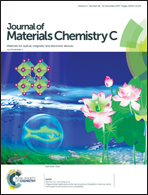A small bandgap (3E,7E)-3,7-bis(2-oxoindolin-3-ylidene)benzo[1,2-b:4,5-b′]difuran-2,6(3H,7H)-dione (IBDF) based polymer semiconductor for near-infrared organic phototransistors†
Abstract
A (3E,7E)-3,7-bis(2-oxoindolin-3-ylidene)benzo[1,2-b:4,5-b′]difuran-2,6(3H,7H)-dione (IBDF)-based small bandgap donor–acceptor (D–A) polymer (PIBDFBTO-HH) was synthesized, which contains a strategically chosen solubilizing electron-rich building block, 3,3'-bis(dodecyloxy)-2,2′-bithiophene (BTO) as a donor. PIBDFBTO-HH has a very small band gap of 0.95 eV, absorbing up to 1700 nm in the near-infrared (NIR) region, which enables its application in NIR photodetection. This polymer exhibits efficient ambipolar charge transport properties with balanced hole and electron mobilities of up to 0.16 cm2 V−1 s−1 and 0.14 cm2 V−1 s−1, respectively, in organic thin film transistors (OTFTs) in the absence of light. In the p-channel operation regime, the organic phototransistor (OPT) devices based on PIBDFBTO-HH demonstrated photosensitivities (P) of 130 and 40 under the illumination of 850 nm and 940 nm LED light sources, respectively. The photoresponsivity (R) under the 940 nm LED reached 450 mA W−1. In contrast, in the n-channel operation regime, a negative photoresponse, namely a decrease in the drain current, was observed, which accounted for the increased number of trapped electrons that offset the applied gate bias.
![Graphical abstract: A small bandgap (3E,7E)-3,7-bis(2-oxoindolin-3-ylidene)benzo[1,2-b:4,5-b′]difuran-2,6(3H,7H)-dione (IBDF) based polymer semiconductor for near-infrared organic phototransistors](/en/Image/Get?imageInfo.ImageType=GA&imageInfo.ImageIdentifier.ManuscriptID=C7TC03584E&imageInfo.ImageIdentifier.Year=2017)


 Please wait while we load your content...
Please wait while we load your content...